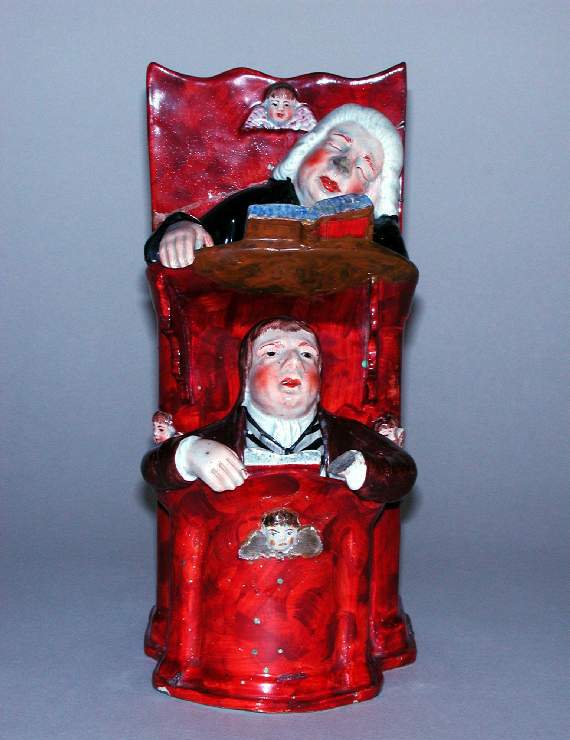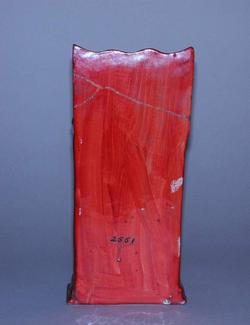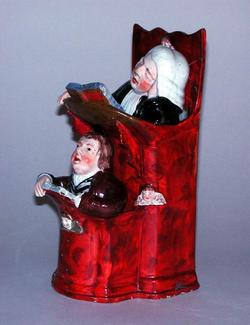Current Location: In storage
Titles
The Vicar and Moses
Maker(s)
Production:
Unidentified factory
Entities
Categories
Description
Lead-glazed earthenware painted in polychrome enamels: a sleeping parson and his clerk in a two tier pulpit
Earthenware, moulded, coated with slightly blue tinted lead-glaze, and painted in blue, flesh pink, red, reddish-brown, brown, grey and black enamels. A rectangular pulpit, with curved lower tier at the front, occupied at the top by a sleeping vicar with his head resting on his left hand; and at the bottom, by a speaking clerk. Each figure has his right hand draped over the front of his pulpit, on which rests an open bible, each having 'chap' written at the top of the left page and ' +' at the top of the right. The clerk's left hand was originally lifted upwards as if blessing, but is now missing. The vicar wears a white wig and clerical dress - a black cassock with white bands; the clerk has brown hair and wears a brown jacket and a grey and black striped waistcoat. the bibles have brown bindings and pages edged in blue. The pulpit has a flat back and is dappled all over in two shades of red and reddish-brown and decorated with four small angels moulded in relief. The underside is flat and unglazed, with a large central ventilation hole.
Notes
History note: Bought from Mr Woolstan of Hyde Park Corner, Cambridge, on 4 December 1905, for 15/- (fifteen shillings), by Dr J.W.L. Glaisher, FRS, Trinity College, Cambridge.
Legal notes
Dr J. W. L. Glaisher Bequest, 1928
Measurements and weight
Height: 22 cm
Acquisition and important dates
Method of acquisition: Bequeathed
(1928-12-07)
by
Glaisher, J. W. L., Dr
Dating
19th Century, Early
Circa
1800
-
Circa
1835
Note
The earliest Staffordshire figure groups of The Vicar and Moses were decorated with coloured glazes and made by Ralph Wood (1748-95) of Burslem, c. 1782-1795. An example in the Metropolitan Museum of Art, New York, has the title impressed across the front of the pulpit (inv. no. 12.80.1), as does an example in the Fitzwilliam Museum (C.21-1929). Similar groups decorated in enamels, like this one, appeared from the early 1800s and versions were made throughout the century. Although these all feature the double pulpit and sleeping vicar, variations in quality and modelling show they were produced by different potters - the Fitzwilliam holds two such different versions – and there are also later copies in circulation. A different group with the same title was made by Enoch Wood, c.1790-1810, and shows the parish clerk leading the drunken vicar to the church. A satirical ballad, ‘The Vicar and Moses’, by George Alexander Stevens, published c. 1772, which tells of a drunken vicar assisted in his duties by his clerk, Moses, almost certainly influenced the production of both these groups. The double pulpit format here seems to be inspired by William Hogarth's engraving, ‘The Sleeping Congregation’, which shows the parson preaching while his clerk and the congregation sleep, first published in 1736.
Pearlware figures decorated with enamels and showing scenes from everyday life and topical events became popular in the early 19th Century. Early examples are often complex, with modelled and moulded parts and applied decoration; the backs, though flat, are decorated. However, by c.1835 these methods had largely given way to three-part press-moulding which enabled faster and cheaper production for a growing market.
People, subjects and objects depicted
Components of the work
Decoration
composed of
enamels
( blue, flesh pink, red, reddish-brown, brown, grey and black)
lead-glaze
Base
Depth 12.2 cm
Width 10.2 cm
Materials used in production
Earthenware
Techniques used in production
Moulding
: Earthenware, moulded, covered with slightly blue tinted lead-glaze and painted with blue, flesh pink, red, reddish-brown, brown, grey and black enamels
Inscription or legends present
- Text: chap +
- Location: On left and right sides of both open bibles
- Method of creation: Painted in black enamel
- Type: Inscription
Inscription present: rectangular white paper stick on label with a blue line edging the right and left sides, and two small leaf motifs in the top corners
- Text: No.2551/Group of the/Vicar and Moses/(Staffordshire),/ good colour/& modelling. the/stand/ b. in Cambridge/Nov 17 1905
- Location: Underside of base
- Method of creation: Rectangular paper label handwritten in black ink
- Type: Label
References and bibliographic entries
Identification numbers
Accession number: C.916-1928
Primary reference Number: 76357
Old object number: 2551
Stable URI
Audit data
Created: Saturday 6 August 2011
Updated: Tuesday 27 August 2024
Last processed: Tuesday 15 July 2025
Associated departments & institutions
Owner or interested party:
The Fitzwilliam Museum
Associated department:
Applied Arts







